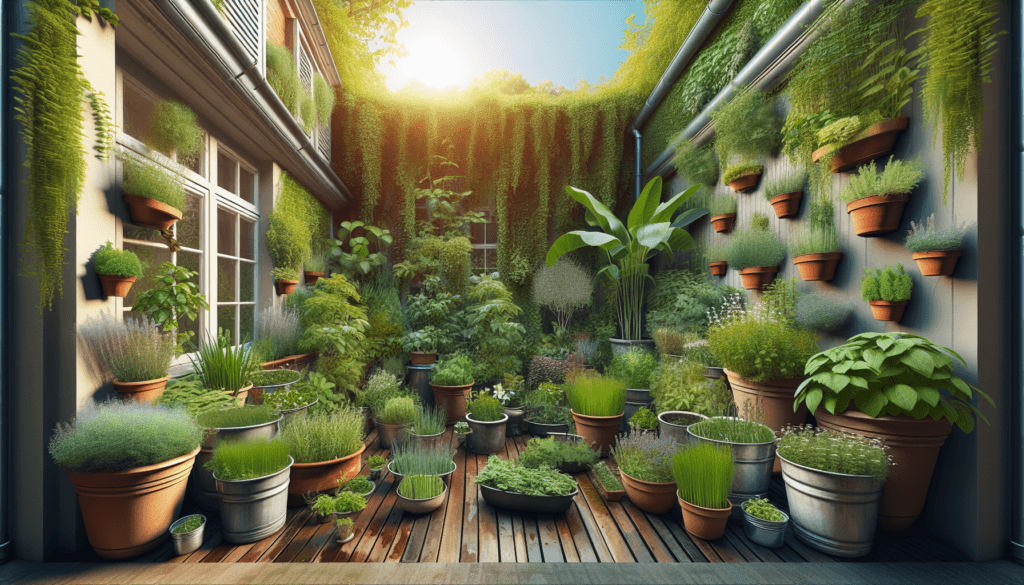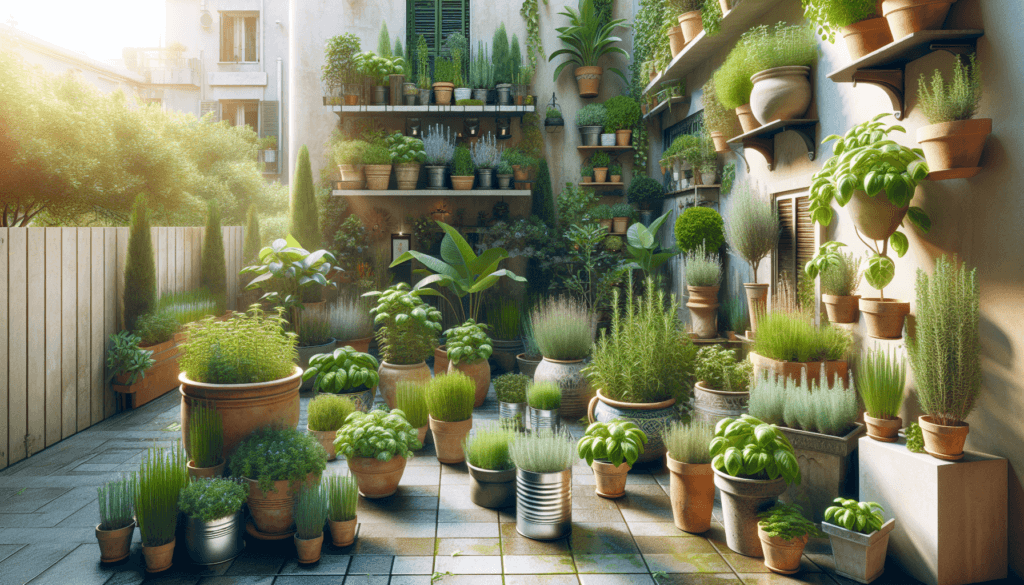If you’ve always dreamed of having a lush herb garden but thought it was impossible in your urban dwelling, think again! The Ultimate Guide to Growing Herbs on Your Urban Patio is here to show you that creating a flourishing garden right outside your doorstep is easier than you might think. Whether you’re a seasoned gardener or a complete beginner, this comprehensive guide will equip you with all the knowledge and tips you need to successfully grow a variety of herbs in the limited space of your urban patio. With practical advice on choosing the right herbs, optimizing sunlight, and implementing effective watering techniques, this guide will transform your outdoor space into a thriving oasis of aromatic and flavorful herbs. So, grab your gardening gloves and get ready to cultivate your very own urban herb haven!
Choosing the Right Herbs for Your Urban Patio
When it comes to starting your own herb garden on your urban patio, there are a few key factors to consider. The first is your climate and sunlight conditions. Different herbs thrive in different climates, so it’s important to choose herbs that are suitable for the weather conditions in your area. Additionally, you’ll want to take note of the amount of sunlight your patio receives throughout the day. Some herbs require full sun, while others can tolerate partial shade.
Another important consideration is selecting herbs that are suitable for container gardening. Since you’ll be growing your herbs in pots on your patio, it’s essential to choose herbs that have a compact growth habit and can thrive in a confined space. Some great options for container gardening include basil, thyme, rosemary, parsley, and mint.
Lastly, you’ll want to choose herbs that you frequently use in your cooking. After all, the whole purpose of having an herb garden is to have a fresh and convenient supply of herbs for your culinary adventures. Consider the herbs that you use most often and prioritize those when selecting which ones to grow on your patio.
Lastly, consider the space available on your patio. Take measurements of the area where you plan to place your containers and consider the size of the pots you’ll be using. This will help you determine how many herbs you can comfortably accommodate in your urban patio herb garden.
Preparing Your Urban Patio for Herb Gardening
Before you start planting, it’s important to prepare your urban patio for herb gardening. First, assess the drainage and soil quality of your patio. Herbs prefer well-draining soil, so it’s important to ensure that your patio doesn’t have any pooling water or poor drainage. If necessary, you may need to make some adjustments to improve the drainage, such as adding gravel or creating raised beds.
Next, it’s time to clean and sanitize your containers. If you’re using pots that have been previously used, give them a thorough cleaning to remove any dirt or debris. You can use warm soapy water and a brush to scrub them clean. Sanitizing your containers will help prevent the spread of diseases and pests. You can do this by soaking them in a solution of 1-part bleach to 9-parts water for about 10 minutes.
After cleaning your containers, you’ll need to decide on the type of containers you will use. There are various options available, including clay pots, plastic pots, hanging baskets, or even repurposed items like tin cans or wooden crates. Choose containers that have drainage holes to allow excess water to escape and prevent root rot.
Once you have your containers, arrange them on your patio according to the sunlight requirements of the herbs you have chosen. Some herbs need full sun, while others can tolerate partial shade. By placing your containers strategically, you can ensure that each herb receives the appropriate amount of sunlight throughout the day.

Essential Tools and Supplies for Herb Gardening
To successfully grow herbs on your urban patio, you’ll need a few essential tools and supplies. First and foremost, you’ll need a quality potting mix or soil. Herbs require well-draining soil, so it’s important to choose a mix specifically designed for container gardening. This will provide your herbs with the necessary nutrients and ensure proper drainage.
Containers with drainage holes are also essential for herb gardening. Without proper drainage, excess water can build up in the pots and lead to root rot. Look for containers that have drainage holes in the bottom to prevent this issue.
For planting and maintenance, you’ll need a hand trowel and gardening gloves. The hand trowel will help you dig holes for planting and make it easier to handle the potting mix. Gardening gloves will protect your hands from dirt, thorns, and other potential hazards.
Fertilizers or organic compost are also important for the health and growth of your herbs. Herbs can benefit from periodic fertilization to ensure they receive adequate nutrients. You can choose between synthetic fertilizers or opt for organic compost, which is a more sustainable and environmentally-friendly option.
To water your herbs, you’ll need a watering can or hose with a spray attachment. Herbs generally prefer moist, but not waterlogged soil, so it’s important to water them regularly while also allowing the excess water to drain away. A spray attachment can be useful for gently watering delicate herbs or seedlings.
Labels for identifying different herbs are also helpful to have in your herb garden. By labeling each container, you can easily keep track of which herb is which. This is especially useful if you have multiple herbs growing on your patio.
Lastly, small pruning shears or scissors are necessary for maintaining your herbs. Regular pruning helps promote healthy growth and prevents your herbs from becoming overgrown. Pruning shears or scissors make it easy to trim back your herbs as needed.
Planting Herbs in Containers on Your Urban Patio
Now that you have everything you need, it’s time to start planting your herbs on your urban patio. You have two options for getting started – starting seeds indoors or purchasing seedlings from a local nursery or garden center.
If you choose to start from seeds, you’ll need to do so indoors a few weeks before the last expected frost date in your area. This will give your seeds a head start and ensure that your plants are ready to be transferred to your patio when the weather is suitable. Follow the instructions on the seed packets for specific planting and growing instructions.
If you prefer to skip the seed starting process, you can purchase seedlings or established plants from a local nursery. This can be a convenient option if you want to get your herb garden up and running quickly. When selecting seedlings, look for healthy-looking plants with no signs of disease or stress.
Once you have your plants or seedlings ready, it’s time to prepare your containers. Fill each container with potting mix, leaving about an inch of space at the top to allow for watering. Gently firm the soil with your hands or the back of a trowel to remove any air pockets.
Next, create a planting hole in the soil, deep enough to accommodate the root ball of the herb. Carefully remove the herb from its container and place it into the hole, making sure it is centered. Gently press the soil around the base of the herb to secure it in place.
After planting, water the herbs thoroughly to help them settle into their new homes. Give each container a deep watering, making sure that the excess water drains out through the drainage holes. This will help eliminate any air pockets and ensure that the roots are in contact with the soil.
To avoid confusion and keep track of your herbs, label each container with the herb’s name. You can use small plant labels or popsicle sticks with the herb’s name written on them. This will help you identify each herb as they grow and make it easier to care for them accordingly.

Caring for Your Herb Garden on Your Urban Patio
Congratulations, you have successfully planted your herb garden! But the work doesn’t stop there. To ensure that your herbs thrive and provide you with an abundant harvest, proper care is essential.
One of the most important aspects of herb gardening is watering. Herbs generally prefer evenly moist soil, so it’s important to water them regularly. Keep an eye on the top inch of soil and water when it feels dry to the touch. However, be careful not to overwater, as this can lead to root rot. Always allow the excess water to drain away through the drainage holes in your containers.
Another crucial factor to consider is the amount of sunlight your herbs are receiving. Most herbs require at least 6-8 hours of direct sunlight per day to grow and flourish. Monitor the sunlight exposure on your patio and adjust the placement of your containers as needed. If certain herbs are not receiving enough sunlight, consider moving them to a sunnier spot or providing supplemental artificial light.
Fertilizing your herbs is also important for their overall health and growth. While herbs don’t typically require heavy feeding, they can benefit from periodic fertilization. You can choose to use synthetic fertilizers specifically formulated for herbs or opt for organic compost, which provides a slow-release of nutrients. Follow the instructions on the fertilizer package or compost bag for proper application and frequency.
Pruning and harvesting your herbs is not only a means of maintaining their shape and size, but it also promotes new growth. Regular pruning helps prevent your herbs from becoming leggy and encourages bushier, more compact growth. You can use small pruning shears or scissors to trim back your herbs as needed. When harvesting, be sure to only remove a small portion of the plant at a time to allow it to continue growing.
While caring for your herb garden, it’s important to be on the lookout for pests and diseases. Common pests that can affect herbs include aphids, spider mites, and whiteflies. Inspect your plants regularly for any signs of infestation, such as yellowing leaves or sticky residue. If you notice pests, you can try organic remedies such as insecticidal soaps, neem oil, or introducing beneficial insects like ladybugs. If a plant becomes diseased, promptly remove it from your garden to prevent the spread to other plants.
Harvesting and Using Your Homegrown Herbs
One of the most rewarding aspects of herb gardening is being able to harvest and use your homegrown herbs in your cooking. Here are some tips for harvesting your herbs at the right time to ensure the best flavor and aroma:
Harvest in the morning: The flavor and aroma of herbs are strongest in the morning, so it’s best to harvest them before the heat of the day.
Harvest before flowering: Herbs tend to have the best flavor before they flower. Once the plant starts to produce flowers, the energy is diverted away from the leaves, resulting in a less potent flavor.
When it comes to preserving your herbs, there are various techniques you can use. Drying herbs is a popular method that allows you to enjoy their flavors throughout the year. You can hang the herbs upside down in a warm, well-ventilated area until they are fully dried. Another option is to use a dehydrator or oven at a low temperature to speed up the drying process.
Using your fresh herbs in cooking is a delightful experience. Whether you’re adding a handful of basil to your homemade pasta sauce or garnishing a dish with freshly chopped parsley, fresh herbs can elevate the flavor of any meal. Experiment with different herbs and explore new recipes to fully enjoy the fruits of your urban patio herb garden.
If you’re feeling adventurous, you can also create homemade herbal teas and infusions. Infusing herbs in hot water allows their flavors and aromas to release, resulting in a soothing and flavorful beverage. Some popular herbs for tea include mint, chamomile, lemon balm, and lavender. Experiment with different combinations and find your favorite herbal blends.

Common Mistakes to Avoid in Urban Patio Herb Gardening
While herb gardening on your urban patio can be a rewarding and enjoyable experience, there are a few common mistakes to watch out for. By being aware of these pitfalls, you can ensure the success of your herb garden.
Overwatering or underwatering your herbs is a common mistake that many beginners make. It’s important to strike the right balance – herbs generally prefer moist soil, but they don’t like to sit in waterlogged conditions. Allow the top inch of soil to dry out between waterings, and always make sure excess water can drain away from the containers.
Planting incompatible herbs together is another common mistake that can lead to poor growth and unhealthy plants. Some herbs have different water, nutrient, or sunlight requirements, so it’s important to do your research and choose herbs that have similar needs if you plan to plant them together in the same container.
Neglecting to prune your herbs can result in leggy and unruly plants. Regular pruning helps maintain the shape and size of your herbs and promotes new growth. Don’t be afraid to trim back your herbs as needed to keep them in check and encourage bushier growth.
Not providing enough sunlight is another mistake to avoid. Most herbs require ample sunlight to thrive, so it’s crucial to ensure they receive at least 6-8 hours of direct sunlight per day. If your patio doesn’t get enough sunlight, consider moving your herbs to a sunnier spot or invest in supplemental artificial lighting.
Neglecting to check for pests and diseases can quickly lead to a decline in your herb garden. Regularly inspect your plants for any signs of infestation or disease, such as yellowing leaves, discoloration, or wilting. By catching and addressing these issues early on, you can prevent them from spreading to other plants and minimize damage.
Dealing with Common Pests and Diseases in Herb Gardening
While no gardener wants to encounter pests or diseases in their herb garden, it’s important to be prepared and know how to deal with them. Here are some common pests that can affect herbs, along with natural remedies for pest control:
Aphids: These small insects feed on the sap of your plants and can cause stunted growth and leaf curling. To control aphids, you can use insecticidal soaps or a mixture of water and dish soap to spray on the affected plants.
Spider Mites: Spider mites are tiny pests that suck the sap from your plants, causing yellowing leaves and visible webs. To control spider mites, you can use a mixture of water and neem oil or introduce beneficial insects like ladybugs.
Whiteflies: These small, moth-like insects can quickly infest your herbs and cause leaf yellowing and stunted growth. To control whiteflies, you can use yellow sticky traps to catch adult flies or spray the affected plants with a mixture of water and insecticidal soap.
Preventing pests and diseases is always preferable to treating them. Some preventive measures you can take in your herb garden include maintaining proper sanitation, providing adequate air circulation, and regular inspecting your plants for any signs of trouble. Additionally, practicing crop rotation can help reduce the risk of pests and diseases by disrupting their life cycles.

Maximizing Space in Your Urban Patio Herb Garden
If you have limited space on your urban patio, don’t despair! There are several techniques you can use to maximize the space and grow a bountiful herb garden.
One option is vertical gardening, which involves utilizing vertical spaces to grow your herbs. You can install trellises or wall-mounted planters to create a green wall of herbs. This not only saves space, but it also adds a visually appealing element to your patio.
Hanging herb baskets are another great way to maximize space. You can hang baskets from hooks or overhead structures to grow herbs such as oregano, thyme, or trailing varieties of mint. Hanging baskets not only save floor space but also add a charming touch to your patio décor.
Utilizing windowsills or balcony railings is also a smart use of space. You can place small pots on windowsills or use railing-mounted planters to grow herbs that thrive in full sun. This way, you can take advantage of the vertical space and allow your herbs to soak up the sunshine.
Finally, stacking containers or using tiered shelves can create a layered effect and maximize the number of herbs you can grow. By going vertical, you can fit more plants in a smaller area while still allowing each herb to receive the necessary sunlight and space to grow.
Joining a Community Garden or Sharing Space for Herb Gardening
If you’re passionate about herb gardening but lack the space on your urban patio, joining a community garden or sharing space with neighbors can be a wonderful solution.
One of the benefits of joining a community garden is the sense of community and shared knowledge. You can learn from experienced gardeners, exchange tips and ideas, and build new friendships with like-minded individuals. Additionally, community gardens often have a wider range of gardening tools and resources that you can access.
If joining a community garden isn’t an option, consider reaching out to your neighbors to see if they would be interested in sharing space for herb gardening. Many urban dwellers have limited patio or balcony space, and collaboration can help maximize the available area. By pooling resources and splitting the responsibilities, you can create a vibrant shared herb garden that benefits everyone involved.
In conclusion, herb gardening on your urban patio is a rewarding and enjoyable endeavor. By considering your climate and sunlight conditions, selecting suitable herbs, preparing your patio, and using the right tools and supplies, you can create a thriving herb garden. Remember to care for your herbs by watering, monitoring sunlight exposure, fertilizing, pruning, and protecting them from pests and diseases. Harvest and use your homegrown herbs in your cooking, experiment with preservation techniques, and enjoy the delightful flavors and aromas they bring to your dishes. Avoid common mistakes, deal with pests and diseases promptly, and maximize space by utilizing vertical gardening techniques or sharing with neighbors. Whether you have a small or large patio, there’s always room for a vibrant herb garden that adds freshness and flavor to your urban living.



